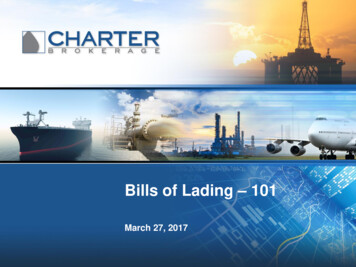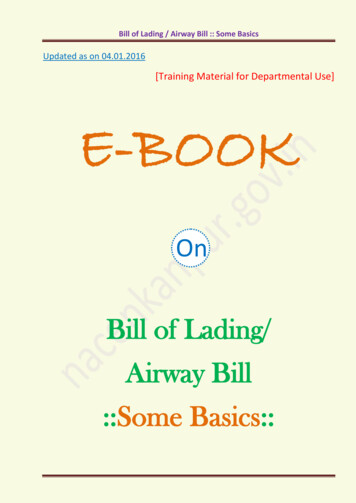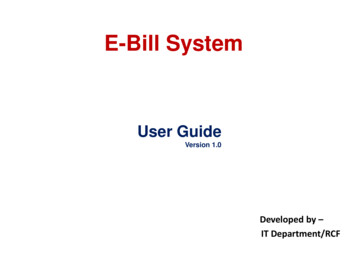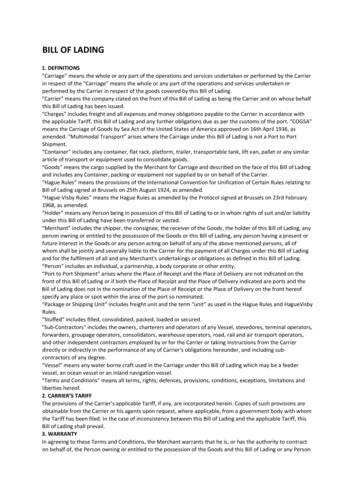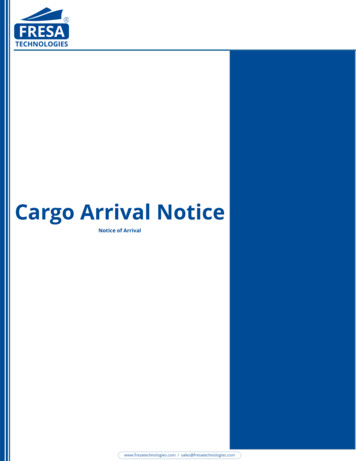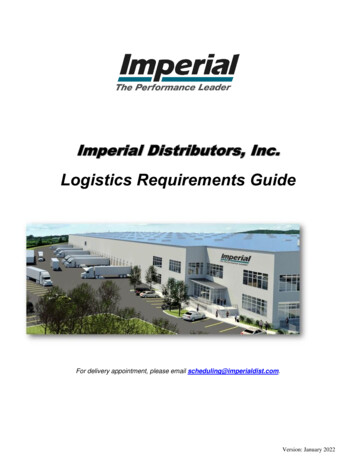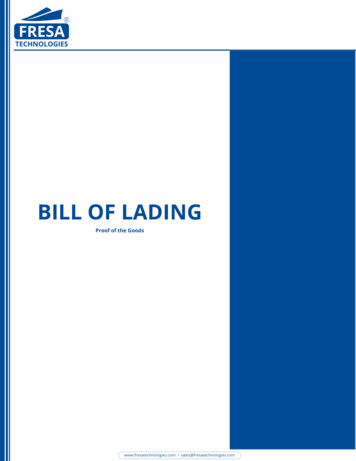
Transcription
BILL OF LADINGProof of the Goods
IntroductionWhat is Bill of Lading?A bill of lading (BL or BOL) is a legal document issued by a carrier to a shipper that detailsthe type, quantity, and destination of the goods being carried. A bill of lading also serves asa shipment receipt when the carrier delivers the goods at a predetermined destination. Thisdocument must accompany the shipped products, no matter the form of transportation, andmust be signed by an authorized representative from the carrier, shipper, and receiver.Bill of lading is one of the most important documents in the shipping process. To ship anygoods, a bill of lading is required and acts as a receipt and a contract. A completed BOL legallyshows that the carrier has received the freight as described and is obligated to deliver thatfreight in good condition to the consignee.As an example, a logistics company intends to transport, via heavy truck, gasoline from aplant in Texas to a gas station in Arizona. A plant representative and the driver sign the billof lading after loading the gas on the truck. Once the carrier delivers the fuel to the gasstation in Arizona, the truck driver requests that the station clerk also sign the document.See the Bill of Lading show in Figure 1.1.Figure 1.1.Bill of LadingWhy Bill of Lading?Bill of Lading is the proof of the agreement entered into between the carrier and the Shipper,
or freight owner, in order to carry out the transportation of the freight as per the contractbetween the buyer and the seller.This document is also used as a receipt, signed by the carrier, to confirm that the goodsmatch the description listed on the paperwork, and that they have been received by thecarrier in good order.Lastly, the bill of lading is used to determine who pays for the freight charges and anycustoms fees, and to outline the liability and responsibility for the goods transferred fromthe seller to the buyer.Importance of Bill of Lading?The carrier need not require all originals to be submitted before delivery. It is thereforeessential that the exporter retains control over the full set of the originals until payment iseffected or a bill of exchange is accepted or some other assurance for payment has beenmade to him.A bill of lading, therefore, is a very important issue when making shipments to move thecargo or freight from one point to the other. On one hand it is a contract between a carrierand shipper for the transportation of goods and on the other hand, it serves as a receiptissued by a carrier to the shipper.Purpose of Bill of LadingBill of lading document is meant to act as a transport document enacting as the evidence ofthe contract of carriage of the goods. A negotiable bill of lading has the following legalqualities: It acts as a piece of evidence for the carriage contract containing the terms andcondition under which the goods transportation will be carried out.It represents as a receipt which endorses that the carrier has received the cargo asper the contract and the goods are received in good condition.It is a document of title, permitting the sale of goods in transit and the raising offinancial credit.Most of the local and international system does not consider a bill of lading as adocument of title. It provides the right for the delivery to be made to the possessor.Types of Bills of Lading Bill of LadingAir WaybillInland Bill of Lading
Multimodal Bill of LadingOcean Bill of LadingTo order Bill of LadingBill of Lading is typically used to ship goods to a customer who has already paid for them.Air Waybill (AWB) is the equivalent of an ocean bill of lading used in air transport. However,unlike the ocean bill of lading, it cannot be negotiable; in other words, it may not beconsigned "to order."Inland Bill of Lading are often the first transportation document issued for an internationalshipment. They are used for cargo shipments by rail or road, but not sea.Multimodal Bill of Lading You’ll use this type when you combine shipping methods. Forexample, goods flown from Omaha, Nebraska, to New York City and then shipped to Europequalify for a multimodal bill of lading.Ocean Bill of Lading is used for shipping goods overseas. It authorizes the holder or anotherparty to take possession of the goods. Ocean bills of lading can be straight bills of lading orconsigned "to order" bills of lading.To order Bill of lading “to order” bill of lading is typically a negotiable document. It allowsthe transfer of ownership of the goods outlined in the bill of lading to another party uponendorsement by the party listed as the ultimate consignee on the document. Often underthe terms of a letter of credit, the bill of lading is consigned "to order" or "to order of [named]bank.”Master Bill of LadingA Master Bill of Lading (MBL) is a document created for shipping companies by their carriersas a receipt of transfer. A MBL summarizes the contents of a shipment including the bill oflading numbers assigned to the various items within the shipment, as well as a descriptionof the freight under each bill of lading.The document also includes the terms for transporting the freight and the name and addressof the consignor, or the shipper, and the consignee, the person whom possess the goods.House Bill of LadingA bill of lading issued by a freight forwarder or NVOCC (Non vessel operating companies) iscalled House Bill of Lading (HBL). Once after receiving cargo from shipper after necessarycustoms formalities, the freight forwarder releases House Bill of Lading HBL to the shipper.House Bill of Lading also is a negotiable document and accepted similar to any Bill of Lading.
Normally HBL House Bill of Lading is issued as per the terms and conditions of Multi modelTransport Document Act. The shipper in House Bill of Lading is the exporter or shipper whodelivers goods to freight forwarder and the importer or consignee, the party to whom thecargo has to be delivered by the said freight forwarder. Bill of Lading show in Figure 1.2.Figure 1.2.Bill of Lading
Bill of Lading is typically used to ship goods to a customer who has already paid for them. Air Waybill (AWB) is the equivalent of an ocean bill of lading used in air transport. However, unlike the ocean bill of lading, it cannot be negotiable; in other words, it may not be consigned "to order." .
